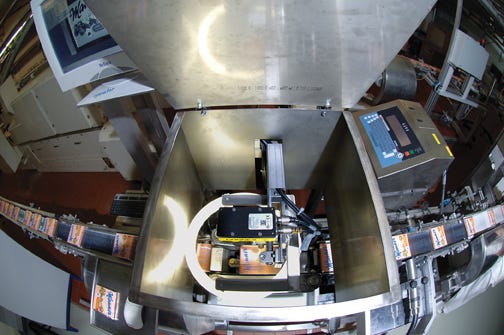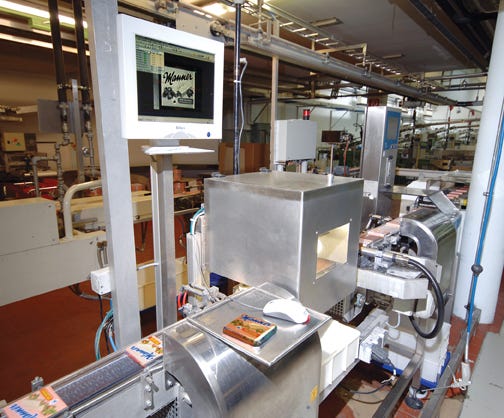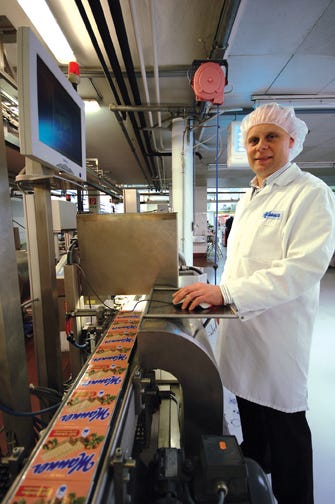January 30, 2014
|
Installed within a quality-control station, the vision sensor checks package labels for equal positioning from the left and right edges, finds any dents or defects, checks for proper graphics and text and much more. |
Responsible for bringing a popular chocolate cookie wafer to fans, Manner AG, the Austrian maker of Mannerschnitte or Neapolitaner (neopolitan) chocolate cookie wafers, strives to ensure that every sweet tooth is satisfied.
First introduced in 1898, Manner's famous wafers have been called Neopolitaners because the nuts for the filling (made from sugar, hazelnuts, cocoa butter and cocoa powder) came from the Napoli region. Today, Manner AG is the largest wholly Austrian producer of confectionery products. Measuring 49x17x17 mm, its wafers are a sweet bite-size treat with four layers of filling between five layers of window-pane-patterned cookie. The format and basic recipe have remained unchanged to the present day.
But only wafer cookies in perfect condition that feature a uniform level of quality can leave Manner's plant in Perg, Austria, for distributon. To guarantee that the packaging for its Mannerschnitte wafers (originally popularized by a distinctive pink package) is thoroughly inspected for any defects, Manner has adopted the In-Sight 5401 vision sensor from Cognex Corp. (www.cognex.com).
Located near Linz, Manner's production plant in Perg generates an annual capacity of 8,000 tons of flat wafers and cookies and employs what could be “the world's largest wafer oven.” The vast product quantities are processed and portion-packed into paperboard cartons with foil and paper wrappers. With hygiene being critical in the food industry, Manner insists that the right products always be packed in the right packaging, which must be as airtight as possible.
In addition, chocolate lovers “cannot be toyed with,” the company says. If the expected hazelnut taste were to be impaired by any packaging problems, customers could be lost. Complaints mean consequences, so Manner insists on product that's 100-percent free of defects. This applies not only to its own brands, but also to those that Manner produces for other customers—an important market segment for the company.
Manner wanted an inspection system that could cope with its increasing quality demands. Such a system would have to meet a proverbial mixing bowl of requirements: Operate reliably at production speeds of up to 400 packages/min; be able to handle different various product configurations; be easy to operate and program; and make packaging production “smoother.”
The system also has to be able to inspect the packages for label positioning, ensure the packages have no dents or other related defects and verify the presence of pictures and text on the labels.
There are 25 wafer package color variants and 100 different labels that must be printed in different languages. Manner realized that such package/product characteristics have to be inspected simultaneously, and would need to be “taught” to the new inspection system.
Integrating a solution
So Cognex partner/system integrator Schmachtl GmbH (www.schmachtl.at), worked with Manner on a feasibility study at the plant, involving the use of the In-Sight 5401 vision sensor for the project. A high-performance model in the Cognex line, the 5401 is an IP65-rated unit with resolution imaging of 1024x768 pixels. The design of Manner's inspection station had to be kept simple, allowing mechanical setup and installation to be done internally by Manner's engineering/maintenance team. The inspection system checks the package label for equal positioning from the left and right edges, finds any dents or defects, checks which picture and text are on the packaging and much more.
|
Above, the package-inspection system is programmed with customer-specific vision tasks. The system had to meet a large set of requirements, including the ability to operate at production speeds of up to 400 packs/min. |
Because the package inspection yield and reliability depend on reputably locating parts, Schmachtl combined the sensor with Cognex's PatMax® object- and feature-location software, which allows the sensor to check various characteristics quickly. One advantage of PatMax is that the individual packages of Mannerschnitte wafers can flow through the inspection station on a conveyor belt without stopping. The vision system's ability to detect packaging faults has allowed Manner to eliminate most product rejects.
Manner ordered the In-Sight unit in April 2006 and installed it within a quality-control station by the end of May. To ensure operator and production efficiency from the start, Schmachtl programmed the sensor with customer-specific vision tasks for a wide range of Manner's wafer package variants. But it was important for line operators to be able to easily manipulate the inspection station.
To take advantage of In-Sight's processing power and function at the production output level Manner was aiming for, the system's entire image area was divided into 12 individual PatMax “windows,” or regions of interest.
Cognex indicates that if there are main points of inspection, the PatMax software can be “trained” to check objects or features for specific characteristics. The vision system works faster if it can simultaneously detect regions of interest (partial windows) of packaging characteristics.
For example, two windows are used solely to determine if the packaging is centered properly while another field is used for pattern matching, meaning that it determines if a graphic of a hazelnut is present. Another field checks the corners of the package for such faults as tears.
Production boost
Finding the compact sensor simple to use and easy to operate, Manner employees say they were able to input various characteristics on the vision system quickly and seamlessly for the entire line of wafer packs. The staff can now react more rapidly to various types of problems that could result in additional unnecessary product rejects. Today, such incidents are kept to a minimum. And by minimizing interruptions in production, productivity has jumped by about 5 percent.
Says Reinhard Gassner, Perg plant manager, “If a conveyor belt is operating at a speed of 270 packages per minute, for example, then just a few seconds of defective production can mean several dozen rejected packages. This isn't just a question of cost, it can have a negative effect on the production flow. But problems like this are now in the past.”
|
Manner’s Reinhard Gassner, plant manager at Perg, oversees the |
Based on the success of the first In-Sight project, Manner says that it plans to evaluate other areas of its operation that could also benefit from a visual inspection system. The results of the sensor installation have also baked up larger product orders and improved quality certification, according to the company, which adds that it now recognizes the Perg plant as a center of competence for all types of technology within Manner AG for its expertise in combining the best engineering with effective vision technology.
More information is available: |
Cognex Corp., 508/650-3140. www.congex.com. |
Schmachtl GmbH, 43 732 76460. www.schmachtl.at. |
About the Author(s)
You May Also Like





